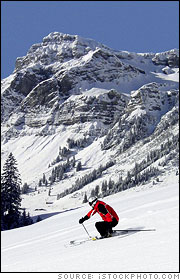The exact origin of skiing is unclear, but there is evidence that Scandinavians were using skis to travel and hunt over snow-covered terrain as far back as 4,000 years ago. Organized slalom races were first introduced in Europe during the 1920s and the first world championship was organized in 1931. Shortly thereafter, Americans caught on and interest in this country snowballed throughout the 1930s. Alpine skiing made its Olympic debut at the 1936 Garmisch-Partenkirchen Games with a men’s and women’s combined event, featuring a downhill and two slalom runs. Giant slalom first appeared at the 1952 Oslo Games and the super giant slalom, or super G, was added at the 1988 Calgary Games. Men and women will each compete in five Alpine skiing events at Torino:
downhill: a steep descent against timeslalom: a short race featuring sharp turns around flagsgiant slalom: longer, looser version of the slalomsuper G: slalom race that is a bit faster and longer than the giant slalomcombined: one downhill run followed by two slalom runs; fastest combined time wins
Men’s events and women’s slalom and giant slalom will take place at Sestriere, 100 km (67 mi) from Torino. Women’s downhill, super G, and combined events will take place at San Sicario Fraiteve, near Sestriere. Event finals are scheduled to occur Feb. 12–25. U.S. hopes are high this year with Bode Miller planning to compete in the Games. Miller took home the overall honors in the 2005 World Cup—the first American to do so in 22 years. And the Herminator—Austria’s Hermann Maier—is expected to return. It’s no coincidence that Western European countries at the foot of the Alps have dominated this sport—particularly Austria, which has won 85 medals, including 26 gold.
More about the 2006 Winter Olympics
